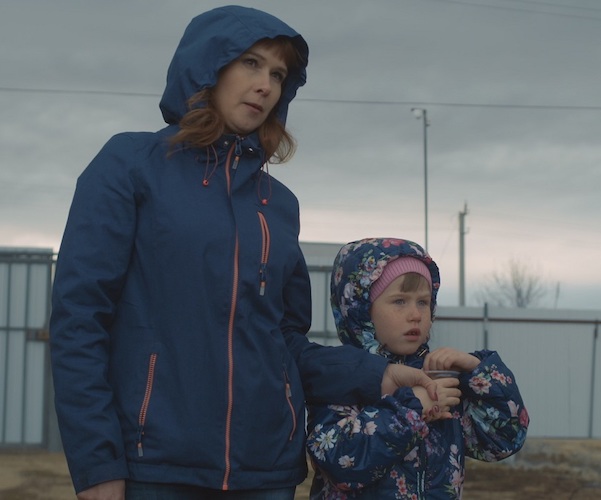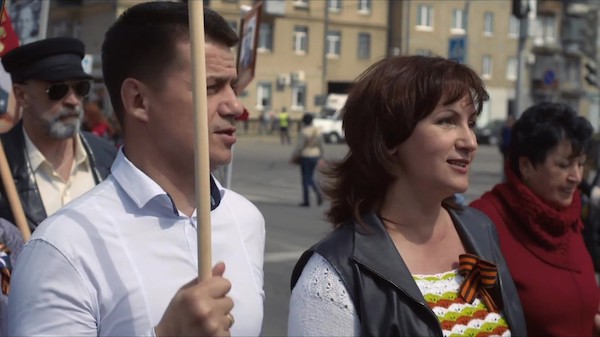Film Review: Wither the People of Magnitogorsk — “Kombinat”
By Ezra Haber Glenn
Without ignoring the terrible-beautiful magnetism of the industrial imagery we love to hate and hate to love, the camera is gradually, gently, drawn across the river and away from the workday, to spend time with these very real humans who serve the machines.

Two members of the Sochin family, from Kombinat.
Deep in the Russian heartland, on the eastern slope of the Ural Mountains, not far from the invisible line separating Asia from Europe, sits the industrial city of Magnitogorsk. It is home to the “Magnitogorskiy Metallurgicheskiy Kombinat,” Russia’s largest refinery of iron and steel — known familiarly, almost affectionately, to locals as just “MMK.” The city plays a vital role in the country’s vast system of state-capitalism. The sprawling manufacturing campus — a city unto itself — covers hundreds of acres of land with gargantuan blast furnaces, towering chimneys, high-tech control rooms, hulking warehouses, and a dizzying network of pipes, conveyor belts, and connector roads and trams, all employed to convert a mountain of ore into millions of tons of steel, churning out billions of dollars in revenue and driving the nation’s economic future in the process.
This is the setting of Gabriel Tejedor’s documentary Kombinat, which patiently, frankly, fairly — and, at times, painfully — explores and exposes the way things work in this modern company town. As this slow-burn tale unfolds, guided by the transporting lens of a sharp and honest documentary filmmaker, we bear witness to equal parts production, pollution, pride, and pathos.
Like Jennifer Baichwal’s visionary collaborations with Edward Burtynsky Manufactured Landscapes (2006) and Anthropocene: The Human Epoch (2018) — or Zhao Liang’s poetically meditative Behemoth (2015) — Tejedor’s camera captures the stunning (and beautiful) scale and power of modern industry. Far more impressive than the light and quirky “edutainment” of the How It’s Made fare you’ll find on YouTube — crayons, clothespins, or Clark bars whirring along an assembly line — here the goal is not to explain a process but to convey a sense of the sheer immensity of an entire manufacturing system. Watching these images scroll slowly past in an endless tracking tableau of iron and steel, we confront the awesome power of naked divinity unmasked (even on a small screen). Our machines can literally move mountains and transform solid rock into glowing rivers of molten metal: we are the new gods, leaving a wreck of a planet in our wake.
But Tejedor’s film delivers more, moving beyond our undoubted fascination with all this industrial hardscape and devastation. In addition to housing the dark-bright Satanic mills of the country’s bright-dark new future, Magnitogorsk is also home to almost half a million actual people: living and breathing steelworkers and their families who work these production lines, wrangle these machines, and try to survive in the shadow of all-encompassing industry. These lives — and the way their all-too-mortal fates are inextricably interwoven into the future of the international conglomerate and the plant itself — supply the human-scale drama needed for us so we can connect with the narrative on an emotional level. Without ignoring the terrible-beautiful magnetism of the industrial imagery we love to hate and hate to love, the camera is gradually, gently, drawn across the river and away from the workday, to spend time with these very real humans who serve the machines.

A still from Kombinat.
And yet while the camera may leave the factory, these people never fully can. We soon come to recognize that every aspect of their lives — and the health and fates of their children — is controlled by or connected to the plant itself. They shop, play with the kids, learn salsa dancing, or visit a friend for dinner. But there are constant reminders of MMK: the inspirational billboard slogans plastered throughout the city, the background TV news chatter reporting on the latest production levels, the shoptalk that fills every spare hour, the sponsorship of the local clubs, and — visible over the streets and houses everywhere, in shot after shot — the looming presence of the furnaces and smokestacks.
The arrangement seems to be simple, clear, and all-encompassing: the factory and the state will deliver the good life — often, paradoxically, still equated with consumer products from the West: Pringles and Twix bars, the fashions of runway models. In return, they expect from you only loyalty, support, and complete devotion.
Once we become acclimated and attached to these folks, the other shoe drops: there is a price to this prosperity. Industrial accidents are not infrequent. Death seems to be routinely accepted as the cost of stoking business: the commentary on the radio and the gossip around the dinner table both segue breezily from talk of yesterday’s steel orders or a new machine being installed to discussion of the workers killed on the line last week. Such losses are taken in stride, the inevitable hazards of daily work. Likewise, the region suffers cancer rates higher than nearly anywhere else on the planet — the lasting mortal legacy of a century of progress. All around them, the workers and their children are being slowly poisoned by the very air and water.
As we come in closer to meet one family in particular, the human cost of this contamination hits close to home. The young couple struggles to find treatment and special education services for their daughter, who is just starting school but is already exhibiting the signs of neurological problems and development disabilities. They are contemplating moving away (for greener pastures in Siberia, to give you a sense of their options). But, as the resignation in their affect reveals, they know they — like the entire town — are stuck. They cannot confidently navigate the frustrating and exhausting course of bureaucratic hurdles set up between this life and a different one: securing a new job, juggling enrollment deadlines and wait-lists for limited school spots, finding new housing. A sigh and a change of subject says it all.
Like these families as they patiently process their lot, Tejedor’s pacing is unhurried and moody — though there are flashes of comfort as well as distraction — creating an appropriately slow-burning urgency. Perhaps the strangest and, upon reflection, the truest aspect of the film is the resigned way these people accept their situation: one day at a time. There’s a beautiful scene of a day at the lake, with just enough remaining nature to distract from the silent and invisible poison we know is all around: the light plays on the ripples in the water, a stand of beautiful birches hold court, noble and stark. It’s a good day.
As the film grinds on and winds down, dreams of escape take on a minor key — “someday, but not now…” The accumulating power of industrial allegiance, patriotism, consumerism, and worker pride grows, crowding out other possibilities. These threads knot together at the city’s grand celebration of MMK’s latest accomplishments: the whole scene is a strange fusion of public ceremony, company picnic, and local cultural festival.
In the blast furnace fueled by a popular belief in progress and civic duty — a sort of industrial manifest destiny — any remaining sense of hope is converted into something more useful and moldable: resignation. The steady accumulation of exhaustion and daily frustration has, over time — through numerous small defeats and obstacles — become the shrug we recognize as “making do.” (After all, despite how most of us remember the poem, the raisin in the sun doesn’t actually explode, but simply dries up and withers away….)
Kombinat will be premiered for US audiences in March as part of the 2021 Texas Thin Line Film Festival.
Ezra Haber Glenn is a Lecturer in MIT’s in the Department of Urban Studies & Planning, where he teaches a special subject on “The City in Film.” His essays, criticism, and reviews have been published in the New York Observer, CityLab, the Journal of the American Planning Association, the Journal of Statistical Software, Experience Magazine, The Arts Fuse, and Next City, and he is the regular film reviewer for Planning magazine. Follow him on UrbanFilm and @UrbanFilmOrg.
